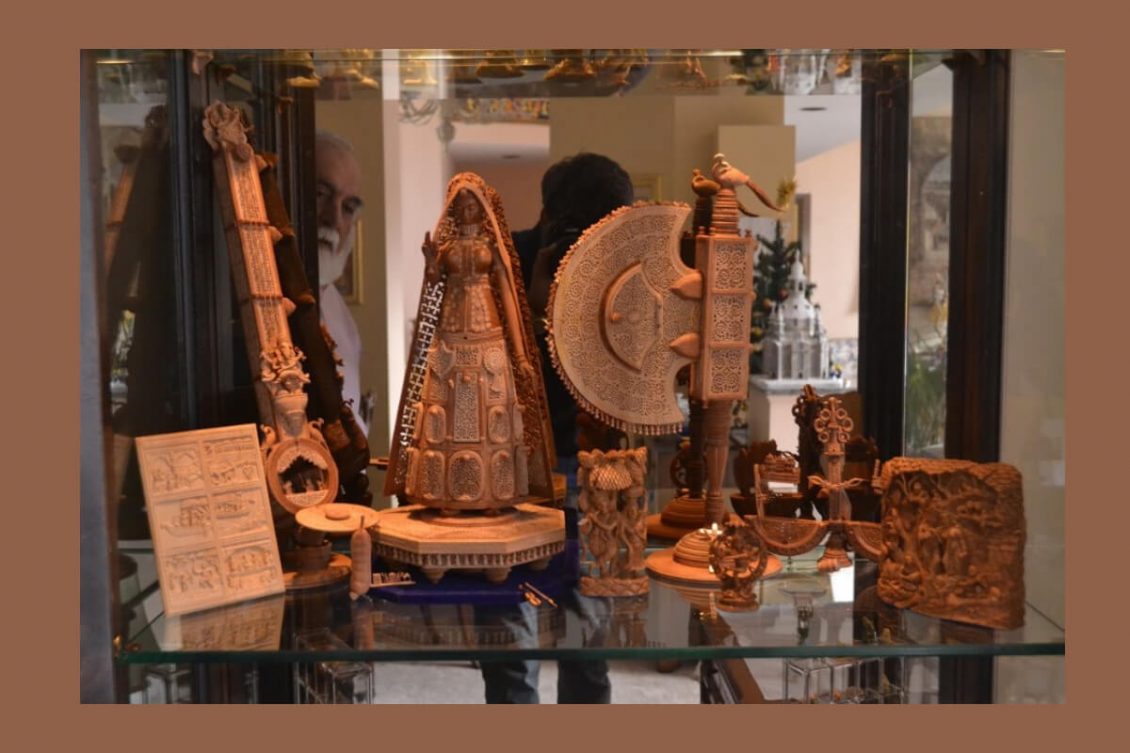Author: admin
Everything you need to know about Jaipur’s Wood-Carving Miniature Art
About Jaipur Wood-Carving Miniature Art

Rajasthan, the Royal State of India, is a place that has given birth to some amazing and intricating art forms. These art forms have their style-statement that people around the world love to carry or hold. Whether we talk about Jaipur Block Printing, Jaipur handmade paper, or Blue Pottery of Jaipur, there is no compromise made with the quality of the handmade product. In this blog, we will discuss another handcraft from Jaipur that has still maintained its name in the list of handcrafted art- Jaipur Wood- Carving Miniature Art.
Let’s know about it.
What is Jaipur Wood-Carving Miniature Art?

It is an art widely practiced in Jaipur, Rajasthan, that shapes different objects by using wood. Wood-Carving is a technique that is also used in Jaipur Block Printing, but Miniature Art is slightly different from Block Printing Art. Here, the wood is chosen based on an object that needs to be designed. Then, the wood is intricately carved into beautiful figures such as God, monuments, Animals, and the like using carving tools. Sometimes, the figures are polished after the carving process to look complete, smooth, and lustrous.
The Emergence of the Art
The Art has got its kick from the architectural designs done on the walls of the palace. And now, after many years, Jangid Family has helped in preserving the art form. Not only in preservation but also flourishing art all over the world. Let’s know about Jangid Family from Rajasthan, who has made craft items using wood-carving techniques for a long time.
Story of Jangid Family
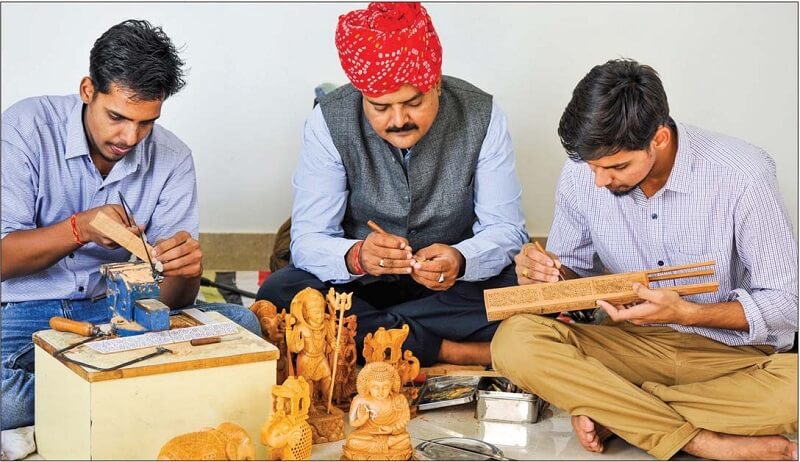
The Jaipur Wood-Carving Miniature Art was started by Mal Chand Jangid, who was given the National Award in 1971 for his skills. These skills were then passed on to his generation. His son, Mahesh Jangid, took the responsibility to stabilize the art. They are known for making creative designs using sandalwood. And through these arts, they narrate a mythological story that helps in relating to the cultural aspects. He made a popular and intricate fan with a story of Lord Krishna in it, for which he was given a National Award in 1993. Even artists from different countries are attracted to their art and skills. And this is how they met George Flores, a miniature collector from America who challenged Jangid’s to make a replica of a 500 years old altarpiece kept in the British Museum. Jangid and his two sons were able to accomplish this task within 6 months only. The piece was complicated to make and carve as it contains 70 human figures and 30 animal figures. The 4 generations of the Jangid Family have indulged themselves in miniature art and are looking forward to dedicating much of their abilities.
These arts have maintained the classic culture of India and enlighten its name all over the world. And the artists who have managed to find their sources out of these arts are not only earning but are saving the traditions from extinction.
The Journey of Jaipur Hand-Block Printing Art
Rajasthan, the Land of Kings, has given so much to be proud of. Everything gives meaning to life, from the art of architectural sculpture to the divine and delectable Marwari cuisine, from dramatic, bright-colored folk costumes to the creative handcrafted commodity. This blog will bring one such traditional art from Rajasthan into the frame and talk it over.
Jaipur, the capital of Rajasthan, is popularly known as “Pink City,” which has an ancient craft called “Jaipur Block Printing Art.” Art is in culture since time immemorial and is accepted globally. So, let’s check what Block Printing of Rajasthan and the history of Block Printing on fabric is.
The Chipa Community introduced the Jaipur block printing art, and this art has been passed down from one generation to another by the different families and communities.
In India, there are many Indian traditional prints. Still, one of the famous prints among them is the hand block printing in Rajasthan, but Rajasthan itself is also famous for various traditional crafts.
This block printing of Rajasthan is done at different places in Rajasthan, and each area is rich in heritage and culture and impacts the art.
The Sanganer place, near Jaipur, is a centre of Jaipur hand block printing, and it receives a lot of limelight due to its closeness to the capital city. It is a significant centre for Jaipur block print art, and the place is located 30 km away from the city.
History of Block Print Art of Rajasthan
The block print, Jaipur art, has been in India for hundreds of years now. This pattern blocking art has always been famous among the royals and has gained more fame and flourished under their guidance and support. These wooden printing blocks or Indian block printing art started in Rajasthan during the 18th century under the rule of Sawai Jai Singh. The history of block printing on the fabric started in Sanganer since the river was a constant water source for the craftsmen or artisans to wash and dye their products.
During this time, many well-skilled artisans were invited from Gujarat and Andhra Pradesh by Sawai Jai Singh to come to Sanganer and open their workshops or make people more skilled in this art. This move paved a path for a major art centre in Rajasthan and created block printing history.
And this move of him slowly became a source of income for thousands of families through different generations.
The Artisan 
The artisans of this art generally belong to the Chippa community. Pattern blocking has been practised for years and generation by generation. As a result, the intricates have been transferred from one generation to another. Every person of the community is involved in making these block printing on fabric, from printing, dyeing, washing, etc. Still, some people do other work apart from the pattern blocking but indirectly help this art form. These people are the wooden block makers, dyers, tailors, suppliers of raw materials. But the leading cause of the success of this art form is the constant availability of water.
Tools used for Jaipur Block Printing
The main tools of this art are the design blocks of different sizes and shapes, mainly made up of wood or metal. The wooden block is made up of teak wood, and the block makers cave out the design on a piece of paper before finally doing it on the wood itself.
Then, the carver chisels the design on the wood, and once ready; it is then soaked in oil for 10-15 days to soften the grain.
There are two different types of blocks: the outline block called Rekh, and the other block, the filler block, known as Datta. For more complicated designs or more clarity, metal blocks are used instead of wooden ones.
Apart from these, one more critical piece of equipment needed by the craftsmen is the printing table, which is mainly made for this art, 3ft high and 3ft wide and 9 ft long. These table surfaces are covered with several layers of cloth, jute canvas, and more than one craftsman can stand and work on the same table.
The Process

These hand block prints include six steps of designing, carving, dyeing, stamping, washing, and drying.
The first step talks about the design; it is usually done on paper. The design is made for the wooden block. The wooden block is then soaked in oil for few days to get ready.
As the design completes, the second step of carving comes into phase. The paper on which the design is made is kept on the wooden block and carved accordingly.
Then the material is selected for the third step of dyeing. The colours are chosen considering the contrasts.
After dyeing the cloth material, the wooden blocks are dipped into the contrasting colour bowl for the fourth step of stamping. The wooden blocks are pressed on the material to print the design at different gaps to give a beautifully printed silhouette.
The next comes to washing to remove the extra, overweighted colour on the cloth and then it is kept outside in free space for sun-dry.
Finally, the material is ironed and packed for selling; the whole process usually takes more than a week.
Colours of Pattern Blocking

One of the facts about block printing is, traditionally, the artisan’s used natural colours. Still, today, in modern block printing, chemical dyes are used, which have, for obvious reasons, are prevalent nowadays. The artisans extracted the natural colours from the fruits and vegetables, and then they formed a basic shade palette of blue, red, green, and black, all the primary colours. The indigo blue was extracted from the indigo plant.
One of the main reasons that make this art so popular is the extraordinary motifs on it. These designs are usually printed over white or cream-coloured cloths, and these designs are generally inspired by nature. The pattern of flowers and plants, fruits, and animal figures are used as a pattern. Since more than one motif is used, the final product usually has more than one pattern on the base. Weapons like daggers are also used as motifs, sometimes.
Types of Block Prints
There are more than ten block printing techniques that enhance the art form. But the most famous ones are:
Bagh:

This art is famous in Madhya Pradesh and is kept on the name of Bagh District, MP. The technique includes geometric shapes and bright colours.
Kalamkari:

This originated in Andhra Pradesh. The technique is quite an exception as the wax is dyeing the cloth blue, and the rest are hand-painted.
Ajrakh:

The artform is from the western states of India and is the same as wooden block printing
Dabu:

This is the special art of Rajasthan and involves a complicated process. It is a time-taking printing technique.
Sanganeri:

This is too from Rajasthan that involves hand printing technique. The fabric is marked for the artisans to print the intricate designs.
Bagru:

The printing originated in the city of Jaipur, Rajasthan. The process involves everything similar to the Jaipur Block Printing, but lastly, the cloth is washed and boiled to get the perfect print.
Modern Block Printing
The modern technical way of Block Printing on fabric is done the same traditional wooden printing blocks. The textile industries have numerous artisans who took charge to save the cultural art from extinction. The Jaipur Hand Block Print is now globally recognized and has high demand all around.
Indian traditional prints have hidden stories behind them. The story of their origination, creation, and passing it on to the generations. These stories are present in each fabric or material that has a splash of art on it.
Also, we would love to know your favourite prints and why do they attract you?
Jaipur Handmade Paper: The Art of Papermaking
The exercise of writing letters and expressing emotions through words has come a long way. Earlier, writing was common on paper, and now we have “digital papers” on our mobile phones and call them by various names. But, somehow, the importance of writing has always been the same, and the arrival of countless replicas of pages couldn’t replace the standard “kaagaz.” Runners don’t hold the patent, but there are different types of handmade papers that build authenticity. In this blog, we will talk about the Jaipur Handmade paper from India, what paper is made from, how is paper made step by step?
What is handmade paper?
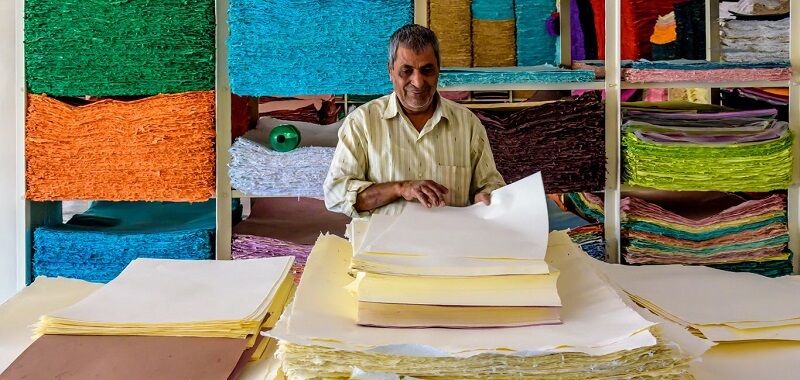
The name itself says that the handmade papers are made by hands using the Moulds and sifting process to set the pulp on the screen and make it dry. The handmade paper turns the waste cotton fabric, wildflowers, leaves, seeds, and used documents into pulp that is then dried to form a sheet. But, how do they make paper? How does the compression take place and get a smooth surface? Let’s see how to make paper from pulp.
Process of making handmade paper
Anything handmade requires a lot of concentration and effort to turn it into a useful masterpiece. And if we talk about handmade pages, the process would be interesting, creative, and soothing simultaneously. The papermaking process involves few steps, and these are;
Converting the cotton into pulp: The pulp used in making handmade paper is purely organic and self-made. Many times dried petals, leaves, seeds are also mixed into the pulp. Then, the mixture is diluted with water.
Extraction of the pulp: after the previous process, the diluted pulp is then poured into the masonry, and with the help of a fine mesh attached to the wooden frame, the pulp is extracted from the mixture and is covered with a muslin cloth. Hence, the pulp is now converted into a sheet.
Beating the sheet and drying: The wet sheet of cotton is then beaten up with the flat brush to make its surface smooth, and for the textured papers, the sheet is beaten up with the patterned brush. And then it is kept under the sunlight, till it gets scorched and with this process, the paper is ready.
Note: no cutting of trees is involved in the process; instead, the textile waste, dried organic substances are used to make an eco-friendly and quality paper.
Handmade Paper Quality

Unlike machinery, the handmade paper material is rich-textured, as the papers are made from cotton and are not compressed poorly. The handmade pieces are large, and the edges are rough, unlike the machine-made forms. The handmade papers are used for multi-purpose like drawing, writing, binding into books, rubber stamping, and more. In addition, these papers are highly utilized in diaries, cards, and creative aspects.
This is how handmade paper is made in Jaipur, India. The paper is so known to everybody that it is event exported globally. The demands of such grade material are appreciated all over the world. The handmade paper industry is ranking gradually in both the national and international markets.
So, next time you use the handmade paper, thank those artisans who use the mechanism of saving trees and producing a good quality paper out of waste. Let us know what you think about the handmade pieces and for what purpose you majorly use them.
Chikankari Art: The traditional embroidery art of Lucknow, India
Indian clothing is equipped with different styles and works done on them to maintain authenticity. So whether we talk about embroidery, hand stitching, or meenakari work, everything has a uniqueness in its way. And whenever we talk about Indian culture and embroidery, Chikankari work always leads the list.
In this blog, we are going to get on detailed information on Lucknawi Chikan embroidery.
Let’s go through it-
Meaning of Chikan
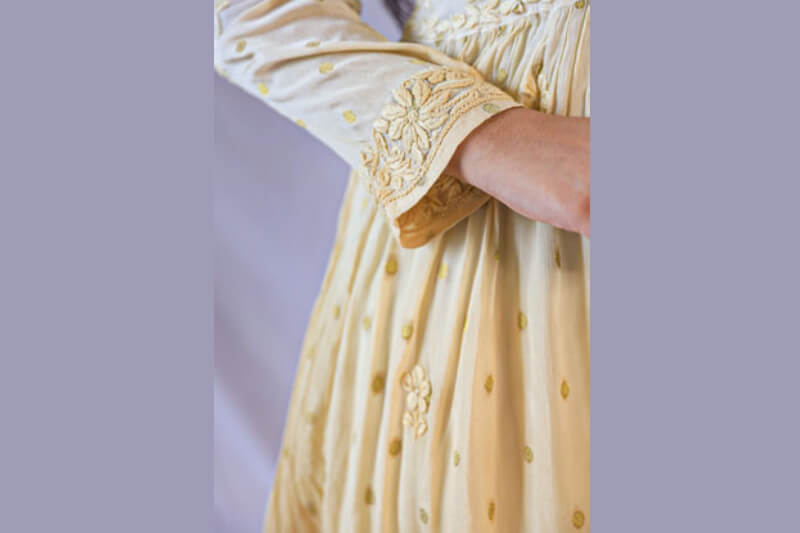
It is a type of embroidery that originated in South Asia and is now a traditional embroidery style from the City of Nawab, Lucknow. Initially, the embroidery was done from a white thread on white cotton material. It is also known as shadow work. Earlier it was done on “mulmul,” but due to the unavailability of mulmul, it is now available in various materials like cotton, wool, chiffon, crepe, silk, and more.
History of Lucknow’s Chikan Work

Noor Jahan, Wife of Jahangir
The Chikankari Embroidery has its root in the Persian culture. The Mughals in India introduce this art.
Once, the travelers were passing through the City of Lucknow, and they asked for water to drink from the peasants, and in return, they taught them the art of Chikankari so that peasants can earn their livings.
Also, Noor Jahan, Mughal Empress and wife of Jahangir introduced the Chikankari in India, and from then, it became more popular.
So, the Chikankari embroidery has numerous stories behind its origination.
Chikan Embroidery designs

You can observe various designs on your Chikankari material that is constantly repeated throughout the piece. In some, large motifs are designed for a single element in a cloth, and some small motifs are put together to form largely designed elements. Some patterns are –
Natural
Geometric
Stylized
Abstract
These are common and popular artwork of Chikankari embroidery.
Chikankari in Modern World
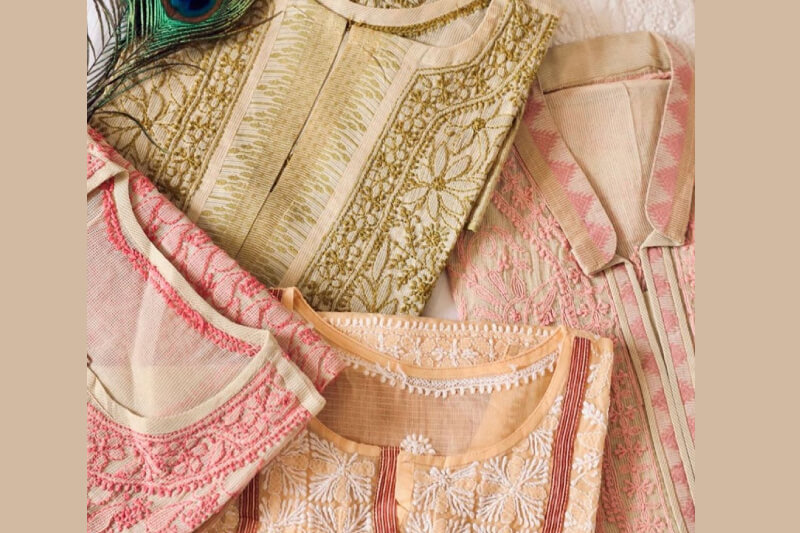
Different trends arrived, flourished, and went away, but love for Chikankari stayed as it is. People feel comfortable wearing Chikankari dresses as it makes them look elegant and classy at the same time. Embroidery is now known globally and even exported abroad. Being the oldest form of art and having connections with the Mughal Dynasty, Chikankari has still maintained its value.
This is what our culture teaches us. Accepting the change is necessary but sticking to our roots and accepting the things around us is what we all should learn. This was all you need to know about Chikankari Embroidery from Lucknow.
All You Need To Know About Phulkari Art of Punjab
Salwar suits and Sarees are considered to be the ethnic dress of India and to compliment it more beautifully; each state has its way of playing with colours, designs and Embroidery. This blog brings one such dressing style known as Phulkari Embroidery into the limelight and sharing the history of Phulkari and types of Phulkari embroidery.

 Handcrafted White Embroid...
Handcrafted White Embroid...  Handcrafted Blue Embroide...
Handcrafted Blue Embroide...  Exclusive Velvet Multipur...
Exclusive Velvet Multipur...  Exclusive Jute Cosmetic P...
Exclusive Jute Cosmetic P...  Handcrafted Front Embroid...
Handcrafted Front Embroid... 